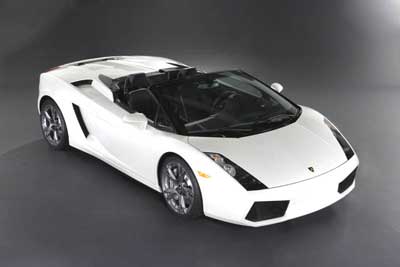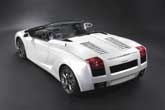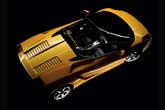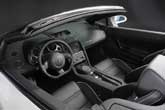Recent Articles
Popular Makes
Body Types
2006 Lamborghini Gallardo Spyder First Drive
The antithesis of Italian ice

MIAMI – We wouldn’t speed in the new Lamborghini Gallardo Spyder. Yeah, we knew about its top speed of 195 mph and how it can rip from 0 to 62 mph in 4.3 seconds, but we still weren’t going to exceed the posted limit. Sure, we got looks; it’s not everyday the folks on Key Largo see an Italian supercar cruising the backroads, especially a mint-green convertible Lambo moving about as fast as a Crown Vic full of retirees. See, we’d heard that the police in the Florida Keys charge for every mile you exceed the speed limit and that they’re eager to do the math to work out your fine. We figured a hot new foreign exotic in paint would only exacerbate the situation. Our wallets aren’t fat, but the Gallardo Spyder sure made it look like they are, so we decided to just idly cruise. Besides, we were on our way to the Homestead Miami Speedway where we’d be able to go as fast as we had the stomach for. We couldn’t afford a fine, but we could afford to be patient. And the Gallardo seemed quite content to loaf along with us, enough that we could see using it to commute – just not in this color.
Model Mix
Model Mix Lamborghini plans to sell just 350 Gallardo Spyders in the United States. The majority of those cars will go to buyers in California, Florida and Texas, making it about as rare as modesty in professional sports and more eye-grabbing than celebrity nude shots. Lamborghini calls the mint green color Verde Picus. There’s also a baby blue officially called Celeste Phoebe. The special hues are meant to attract more women to Lamborghini showrooms, marking the first time in its 40-year history that the Italian marque has targeted female buyers. The Gallardo Coupe (Lamborghini’s best-ever selling model) was predominantly purchased by males, but Lamborghini hopes the convertible top and the pastel shades will convince females to part with 200 grand in unprecedented numbers. () Our favorite colors, regardless of gender, are: Lamborghini’s distinctive yellow (Giallo Halys); the gunmetal grey (Grigio Proteus) that looks wicked-cool with the light, reddish-brown leather interior; and a mesmerizing pearlescent white (Bianco Cygnus) that seemed to change like a mood ring from silver to white to grey in the bright Florida sun. You can further customize your Gallardo Spyder with several different interior packages, such as the $3,910 leather package that blankets nearly every soft interior surface in supple hide. If you’re a fan of the high-tech hatch pattern of carbon fiber you can cover nearly every hard surface on the interior with such trim for $8,510. And if you just love the fierce, snorting bull Lamborghini logo you can pay $910 to have it embossed on the headrests and also etched on the rims and on the dashboard. You can even have a Spyder custom painted in your favorite color for $5,700. Lamborghini plans to sell just 350 Gallardo Spyders in the United States. The majority of those cars will go to buyers in California, Florida and Texas – in that order. In fact, the automaker expects that 36 percent of sales will come from the Golden State alone. So the Gallardo Spyder is about as rare as modesty in professional sports and more eye-grabbing than celebrity nude shots, so we’re not quite sure why you would want to spend $3,250 on the two-piece silver “Callisto” brake calipers, which adds only a slightly different look to the car. But, if you have the money and the need (maybe your neighbor just bought the same car and you want to stand out), they and other items are available as exterior options to further set your Gallardo Spyder apart. Although the 2006 Gallardo Spyder comes pretty much loaded, there are a few options that have little to do with appearances, including a navigation system ($2,600), an anti-theft alarm ($638), heated mirrors ($173), a trip computer ($460), and a rear-view camera ($2,600). Add a few more little extras, such as leather headliner ($995) and heated, power seats ($3,340) and you will be approaching the average cost of a four-bedroom house in most states. Lamborghini expects the most popular option will be E-gear ($10,000), predicting that 80 percent of buyers will want the electronically-controlled sequential shift transmission.

Nuts and Bolts
Nuts and Bolts Mechanically, the 2006 Lamborghini Gallardo Spyder is endowed with a 520-horsepower, 5.0-liter V10 engine. That translates to more than 100 hp per liter and a power-to-weight ratio of a startling 6.7 pounds per horsepower. Mechanically, the 2006 Gallardo Spyder is identical to its fixed-roof 2006 Coupé sibling. Both are endowed with a 520-horsepower (up from 492 in the previous model), 5.0-liter V10 engine crammed with cutting-edge racing technology such as a drive-by-wire throttle system featuring two electronically-controlled throttle valves and intake manifolds with continuously-variable valve timing, which ensure that gas flow is optimized across the entire rev range to make sure there’s a whole lot of power available regardless of what speed you’re driving. Maximum torque of 510 pound-feet is achieved at a meager 4,250 rpm (redline is a heart-racing 8,100 rpm) and 340 lb.-ft. of torque is underfoot at just 1,500 rpm. These figures translate to more than 100 hp per liter and a power-to-weight ratio of a startling 6.7 pounds per horsepower. Imagine Secretariat towing a toy wagon and you get the idea of the Gallardo Spyder’s power. The Spyder, like the Coupé, comes standard with a six-speed transmission. Our test car was equipped with the optional “E-gear,” an electronically-controlled sequential manual transmission. Made by Marelli, which also supplies Ferrari and Maserati, the system uses paddles behind the wheel, which you flick to shift gears. The same technology is used in F1 race cars because it shifts gears much faster than a human being can using a stick and a clutch – as quickly as .0012 of a second. Some drivers complain that E-gear isolates the driver, limiting full participation in the driving experience. We would agree that it’s more fun to actively take control of a manual tranny when you’re cruising a country road and shifting leisurely. On a track, however, when corners arrive in the blink of an eye, it’s nice to have a piece of machinery that’s faster than your eyelid’s involuntary shuttering. It leaves you to concentrate on other matters, such as the concrete wall doing 120 past your right rear wheel. Downshifts with E-gear are accompanied by an electronically-controlled blip of the throttle and a commensurate roar of the engine that gives us goose flesh just thinking about it. All auto journalists like to think we can heel-and-toe like Mario, but too many gourmet dinners and too little time on the track conspire against us. E-gear has four modes: Normal for, well, normal driving; Sport, which makes the fastest possible shifts for dynamic driving; Automatic, which is perfect for stop-and-go urban traffic; and a setting for slippery conditions such as snow (like you’re going to drive this baby in winter). With the “Sport” mode selected, we roared up to bends, downshifted in perfect timbre, nailed the apexes, and upshifted as we blasted out of corners and then ripped up the straightaways, shifting again near redline, making the car jolt and then surge forward as though butted by a bull. We never got tired of that feeling. Our only complaint with E-gear is that the paddles are mounted on the steering column and not attached to the steering wheel. This means that if you want to switch gears in a hard corner you need the dexterity of Gumby. You could argue that we should have the right gear selected before we enter corners, or that we might wish to take up the fine art of shuffle steering, but the technology is about making mediocre drivers magnificent, not picking apart inadequacies. We were also slightly disconcerted by how the E-gear’s throttle blip on downshifts actually sends a blip of power to the drivetrain and isn’t just aural accompaniment. This results in a small surge forward, which, when we downshifted while cruising up to stop lights on city streets, scared the hell out of us – But this was not noticeable on the track, which makes us think that just because the Gallardo Spyder seems okay with everyday, city street driving doesn’t mean it it. The Lamborghini Gallardo Spyder’s permanent four-wheel drive viscous-clutch system kept us glued to the track like gum on a sidewalk. Under normal conditions, power is distributed 30:70 between the front and rear wheels, but when it detects slippage, the system immediately delivers torque to whichever wheels offer the best traction. The suspension system is also tweaked toward slight understeering when entering a corner to prevent body roll, and anti-dive and anti-squat controls ensure the nose won’t dip during braking or rise at take-off. As a result, the Spyder is super-stable even while being thrown around the track. Toss into the mix Lamborghini’s electronic stabilization program (ESP – an invisible third foot that taps the brakes when needed to keep your line true) and we never got that hollow and harrowing feeling of imminent disaster that’s a poor trade-off for a few thrills. At the same time, the Spyder is hardly buttoned-down. Its engineers have imbued it with a bit of liberalism so that we were able to induce a sideways slide on several severe corners and then recover easily and continue our assault on the track record. And if you somehow overwhelm ESP, the Gallardo Spyder’s massively-powerful anti-lock brakes are designed to stop you long before a potential crash becomes reality. With 365mm discs and Brembo eight-piston calipers in front and 335mm discs with four-piston calipers in back, the Spyder pulls more than 1.1 g’s when braking hard. In the unlikely event of a crash, the Gallardo’s super-stiff Audi-designed (the German automaker owns Lamborghini) aluminum space frame (which also provides the base for the car’s tremendous handling), front and side airbags and pop-up roll bars are prepared to make a safety cocoon. And for extreme adventures without electronic interference, you can also click off the ESP and just rely on the brakes, airbags and roll bars to save your skull. However, during our time with the Gallardo Spyder, this was strongly discouraged by Lamborghini because: 1. We didn’t own the car; and 2. Everyone knows those liability waivers we signed are as watertight as a teabag.

Design
Design The Lamborghini Gallardo Spyder’s primary purpose is obvious with one look at its aluminum body. Inspired by the sharp edges and flat planes of Stealth aircraft, it screams speed. The Lamborghini Gallardo Spyder’s primary purpose is obvious with one look at its aluminum body. Inspired by the sharp edges and flat planes of Stealth aircraft, it screams speed. The cockpit is so far forward it looks as though the sleek, blade-like front of the car is outpacing the sharp, boxy rear – even at a standstill. The huge windshield and thick A-pillars are so severely raked they seem pushed flat like prairie grass in a storm. The large air inlets and the trapezoidal bi-Xenon headlight assemblies create the face a determined, predatory demeanor and the high, squared-off rear seems to be snarling. Set atop 19-inch alloys shod with thick slabs of Pirelli PZero rubber, the Gallardo Spyder is fantastic to behold. Though visually arresting, the Spyder’s inverted-wing design has practical roots in aerodynamics. It also helps to maximize airflow to the engine and to generate downforce over the rear axle, an effort which is augmented by a rear spoiler that tilts upward when the car hits 75 mph. The Spyder’s interior is refreshingly simple. Thankfully, Lamborghini surrendered itself to parent company Audi’s industry-leading interior design and quality – the one time that borrowing from a parts bin is high praise and not low condemnation. All controls are simple, sturdy and straightforward – and immediately recognizable to anyone who’s peeked inside an Audi, except for a row of toggle switches on the center stack that were made specifically for the Gallardo and create an appropriate feeling of high-tech, industrial-grade switchgear. Additional creature comforts include dual climate control, a six-disc CD changer, a HomeLink universal transmitter, and power locks, windows and doors. Another welcome bit of owner-friendly technology is a lifting system for the front axle. Operated via a toggle on the center stack, it raises the nose nearly three inches so you can avoid those heart-rending scrapes when you enter a steep driveway or drive over a speed bump. The small-diameter, butter-soft, leather-wrapped steering wheel feels good in hand, is squared at the bottom (F1 style) to make room for your thighs, and tilts and telescopes for a custom fit. Surprisingly, the seating position isn’t that tight. The body-hugging leather bucket seats provided a near vacuum-packed fit, which greatly enhanced our time on the track, but after a couple of hours on the highway, the driver’s lower back tightens and requires constant articulation of the lumbar control for relief. Passengers will notice a boxy protrusion in the footwell that prohibits sprawling. It’s caused by ventilation and electrical works that could not be routed elsewhere. The tiny storage area (four cubic feet) in the front of the Gallardo is barely big enough for a laptop bag and a copy of the Sunday New York Times. But, other than these relatively minor inconveniences, the Spyder seems determined to expunge the stereotype of the Italian exotic that’s hell to actually . The fully-automatic soft top is operated via a switch on the center console and takes about 20 seconds to raise or lower. It is covered by a carbon fiber bonnet, which also stretches over the engine for minimum weight and maximum torsional rigidity. You likely won’t care too much about that when the roof’s down, the wind’s whipping your clothes and hair and you’re carving corners like a knife in cake.

Driving Impressions
Driving Impressions The howl of the engine as E-gear downshifted into a corner and the Lamborghini Gallardo Spyder blasted out the back side produced the same feeling of masterly domination you get when you hit your Ping G2 perfectly and the ball soars 280 yards down the fairway. Though the Lamborghini Gallardo Spyder is low-slung, climbing into it didn’t feel like a gymnastic routine. Of course, most of the time headroom was infinite. But even with the roof up, we were able to get in and out while retaining a modicum of gracefulness. Once underway, we discovered that while there are lots of scary-fast exotic cars out there, not many are as comfortable to drive as the Gallardo Spyder at sedate speeds – as long as you’re not logging hour after hour on the interstate. Another reason we didn’t mind driving the back roads of Key Largo at Snowbird-slow speeds is that the Lamborghini didn’t seem to mind either. It didn’t buck and pitch forward in low gears like a horse impatient with its bridle, eager to gallop. We were, however, a bit disconcerted by the brakes at first. It takes more foot pressure than we expected to get into the meat of the system, but once those 24 calipers grabbed those cross-drilled mamas it was like being in the vice grips of gravity. And we weren’t pounded to scaloppini by the ride. Though it’s solid as granite and strict as a drill sergeant on the track, the car’s front and rear double wishbone suspension is as indulgent and cuddling as your favorite aunt when you’re merely cruising around. The 2006 Gallardo Spyder always like a race car, though. Responding to owner pleading, Lamborghini gave the 2006 Coupé and Spyder an enhanced engine note. It’s fierce. We gunned the motor while passing through a tunnel into Homestead Miami Speedway and our ears rang for an hour afterward. When there were a dozen of these wonderful convertibles doing laps on the track at full song it sounded like race time at an F1 event. Our track experience can only be described as exhilarating. We never shut off the ESP partly because we were warned not to and also because we felt no need to increase the car’s thrill factor. The Lamborghini Gallardo Spyder spins such a fine line between teetering on the edge of control and confidence-inspiring stability that we had our hands full keeping up with our emotions as we piloted it around the track. It made our eyes water as we roared down the straightaways with the massive V10 screaming at our backs. The howl of the engine as E-gear downshifted into a corner and we took advantage of the Gallardo’s slight tendency toward understeer to dive into the apex and glide the car around the turn before blasting out the back side was the same feeling of masterly domination you get when you hit your Ping G2 perfectly and the ball soars 280 yards down the fairway – except that happens once in a blue moon and the Gallardo delivers perfection in every turn. At times we were moving so fast that our clothes whipped like flags on the mast of speed boat. We ducked as cars in front threw up little balls of spent tire rubber when we roared up behind. And, all the while, the Florida sun filled the cabin with pure white sunlight. Back in the pits, with the Lamborghini pinging and whirring as its machinery panted for breath, we hopped from one foot to the other, waiting, just waiting, until we could go round again. We couldn’t get enough.

FAQs and Specs
FAQs and Specs The Lamborghini Gallardo Spyder arrives this spring, but unless you were one of the lucky ones to get in line for the 2006, you’re going to be waiting at least a year to run this puppy up to its top speed of 195 mph. When can I get a 2006 Lamborghini Gallardo Spyder? The 2006 Lamborghini Gallardo Spyder will arrive in the United States in spring, 2006, just in time for warm summer weather. Unfortunately, it is virtually sold out. However, dealers are accepting orders for 2007. How does the convertible top affect the 2006 Lamborghini Gallardo Spyder’s speed? With the roof up the 2006 Lamborghini Gallardo Spyder’s top speed is 195 mph and with the top down it reaches 191. This difference in velocity is insignificant if you ever, ever go that fast. What are the differences between the 2006 Lamborghini Gallardo Spyder and the 2006 Lamborghini Gallardo Coupé? The Spyder’s fully-automatic soft top makes it 265 pounds heavier than the Coupé and the rear deck is totally different. The Spyder has a carbon fiber engine cover that stretches from behind the cockpit to the tail lights, and which also serves as the cover for the soft top. In addition, the Spyder’s rear window can be lowered and raised and there are hidden, pop-up rollover bars behind the headrests. SPECIFICATIONS 2006 Lamborghini Gallardo Spyder $195,000 to $225,000 5.0-liter V10 520 horsepower at 8,000 rpm 510 lb.-ft. at 4,250 rpm Six-speed manual or an electronically-controlled sequential gear shift 3,461 169.3 inches 74.8 inches 46.6 inches 100.8 inches Two 4 cu.-ft. Ferrari F430 Spyder
Photos courtesy of Lamborghini
